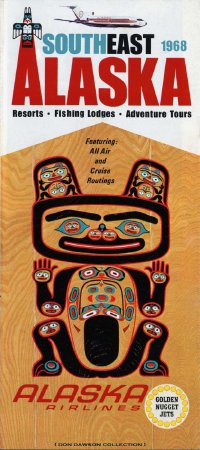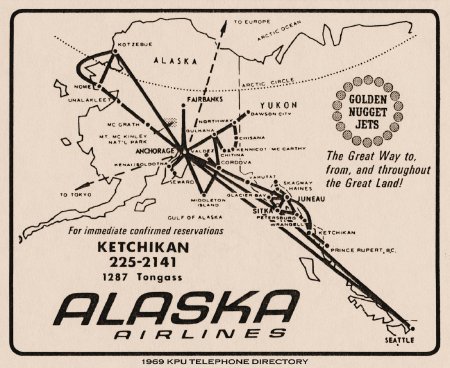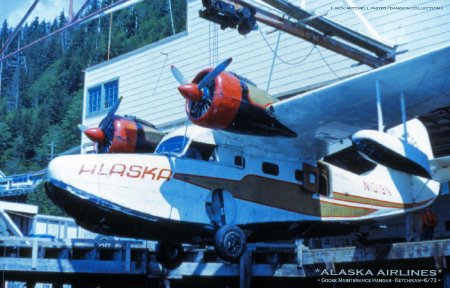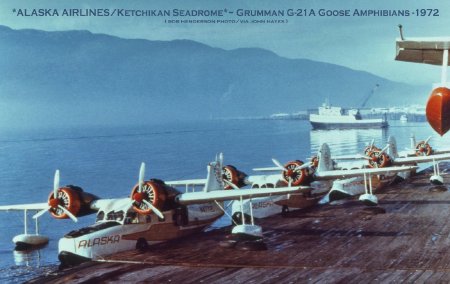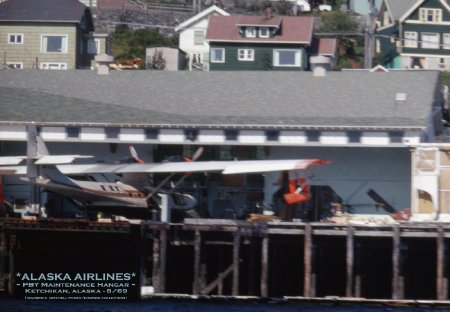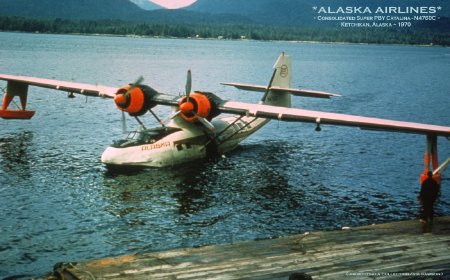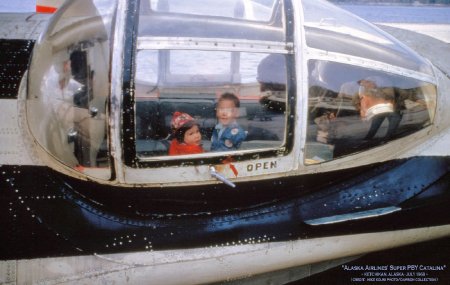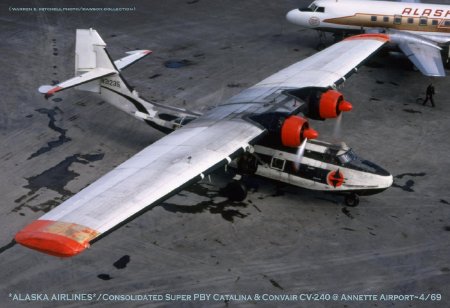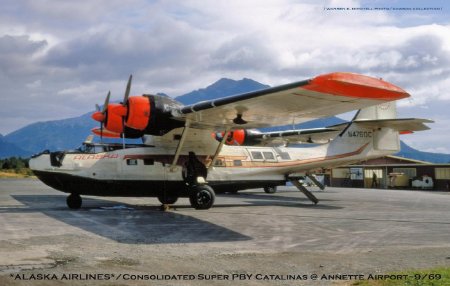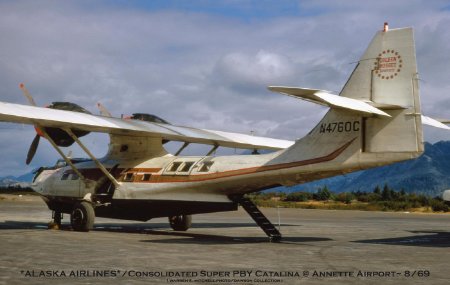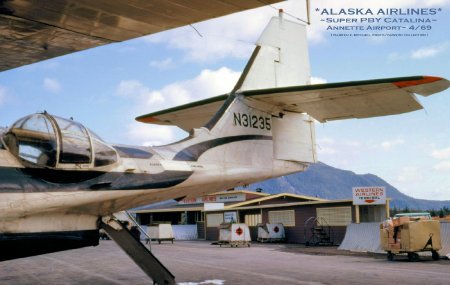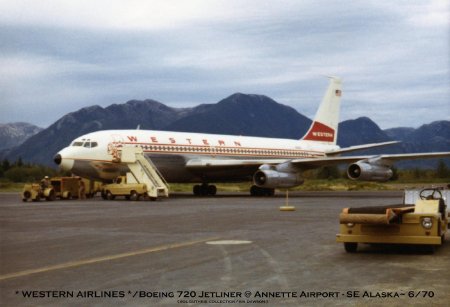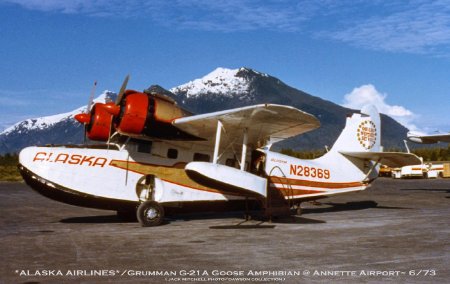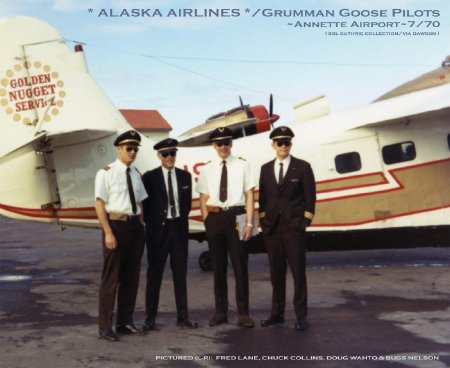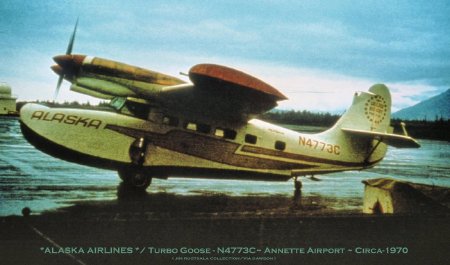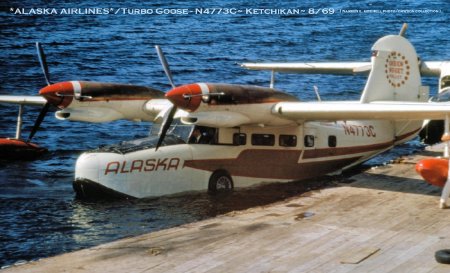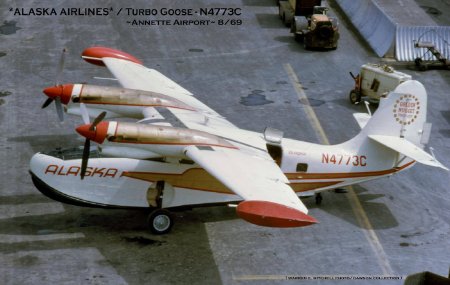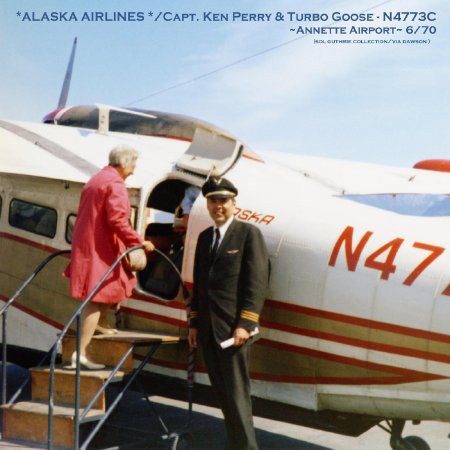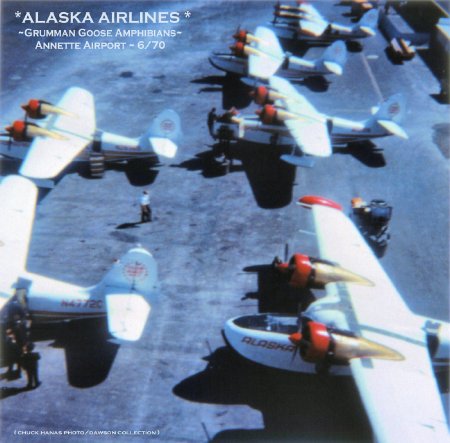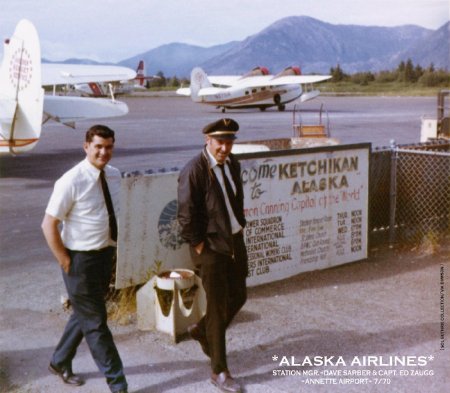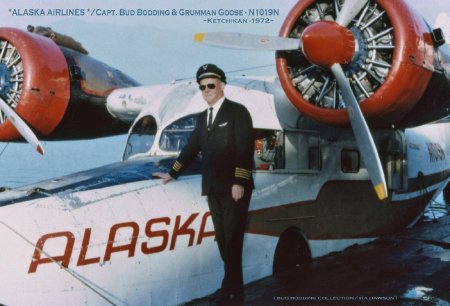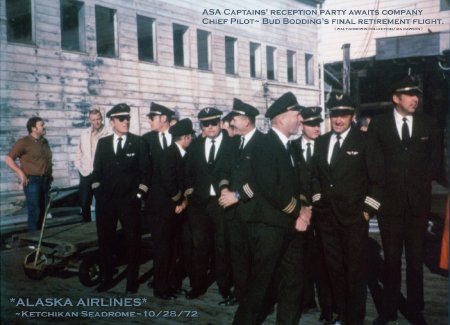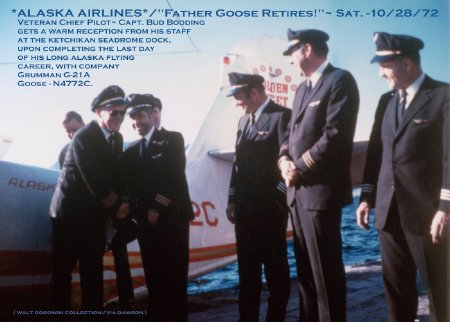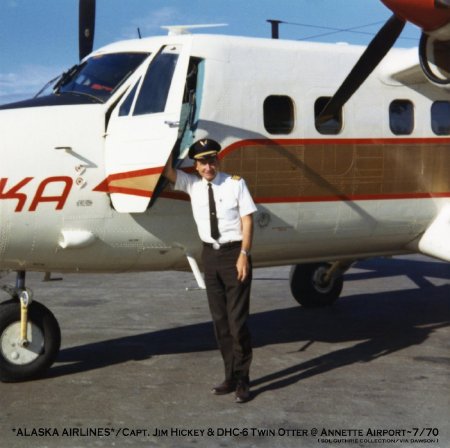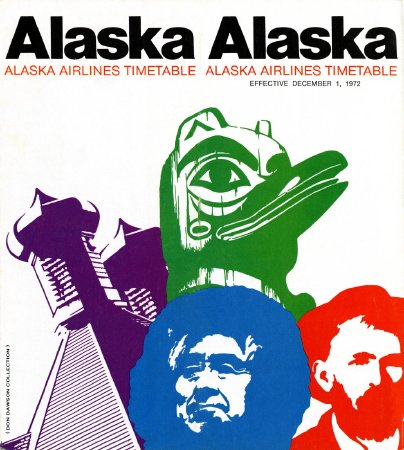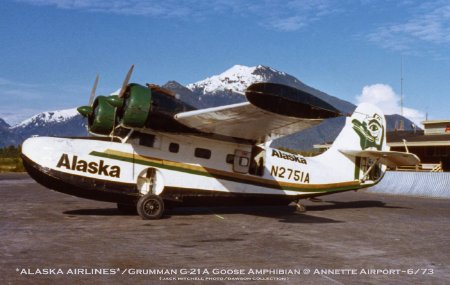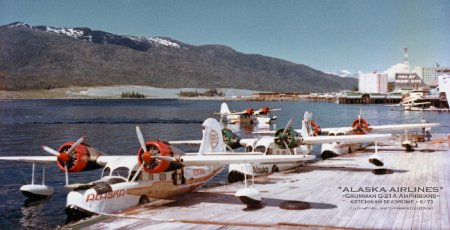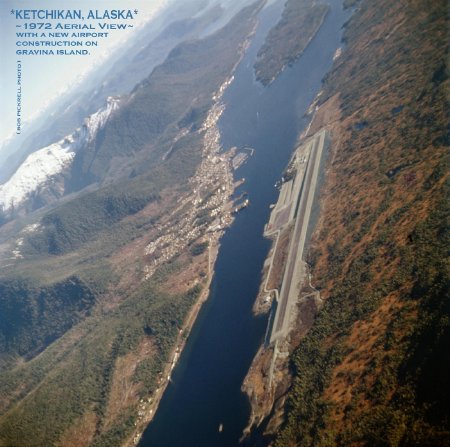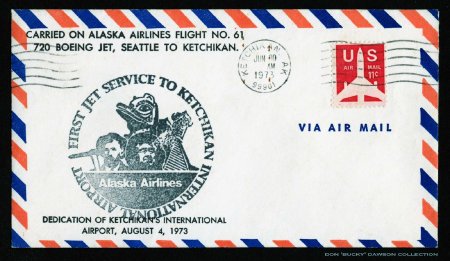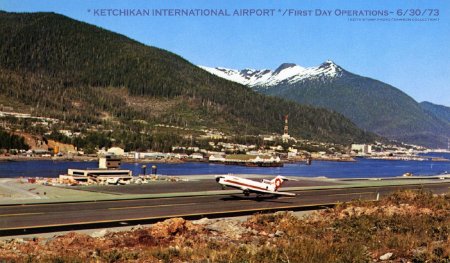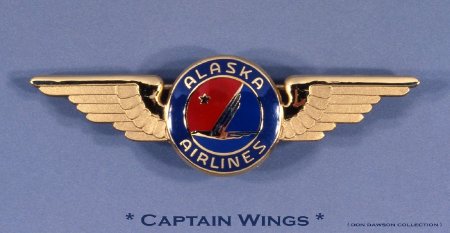Description:
Alaska Airlines (Seaplane Operations), 1968-1973
The long awaited authorization for Alaska Coastal Airlines, Inc. to merge with Alaska Airlines was issued by the Civil Aeronautics Board on March 21, 1968, one day after President Lynden Johnson signed the formal route transfer documents. April 1st was set as the effective date of the merger, six years to the day of the consolidation between Alaska Coastal Airlines and Ellis Air Lines. Alaska Airlines' merger with Cordova Airlines was previously completed on February 1st. The three-way merger gave Alaska Airlines routes, which served over 94 percent of the population areas of Alaska, plus two communities in Canada. Alaska Airlines took delivery of their third brand new Boeing 727 jet liner at the time of the historic merger. Over a half a million passengers were boarded that year. The combined employment of the airline exceeded 1,150 employees, which increased to nearly 1,500 during the heavy summer travel and tour season.
So, the large vintage amphibian airline changed ownership one final time, with Alaska Airlines initially operating from the original old Coastal-Ellis Seadrome in downtown Ketchikan. As part of the merger terms, Alaska Airlines agreed to continue the established Southeast Panhandle operations of the company's venerable Goose and PBY fleet for five more years as part of its "Golden Nugget Service", as the Jet Age began to take over with new regional airports opening in Ketchikan, Sitka, Wrangell and Petersburg, to combine with Juneau. Many of the veteran amphibian fleet pilots transitioned up through the ranks to fly as captains on Alaska Airlines' newly added DeHavilland DHC-6 Twin Otter commuter wheel planes or Boeing 727 jets. Some, like chief pilot Captain Bud Bodding, were content to keep flying the fleet standard R-985 radial powered Grummans, until the last ones were phased out in 1973. Bodding retired on October 28, 1972, after logging his final flight around the company's Panhandle route line with Goose N4772C.
April 1967, the State studied sites for a new Ketchikan Airport, with three possible locations: Pt. Higgins, Pennock Island, and Gravina Island. On August 1, 1967, Gravina was chosen, and the Federal Aviation Administration formally endorsed the Gravina Island choice. Work began April 29, 1969 with the bulk of excavation and runway fill work beginning early 1971. February 29, 1972 the Ketchikan Gateway Borough bond vote approved construction of new terminal building and facilities. The first day of operations for the new Ketchikan International Airport was Saturday, June 30, 1973, with six Alaska Airlines flights scheduled, beginning with the slated 8:45 a.m. morning arrival of Flight 61 from Seattle using a Boeing 720 jetliner, and return departure time at 9:30 a.m. (Note: The 4-engine jet was one of three previous Western/Pacific Northern Airlines Boeing 720s that Alaska Airlines purchased to add to the fleet.) Then a Convair 240 arriving from Juneau, Petersburg, and Wrangell set to arrive at 9:05 a.m., with a 10:30 a.m return flight back to those communities. Third flight was a Boeing 727 jet arriving from Seattle at 9:45 a.m. with a 10:15 a.m. departure for Juneau and Anchorage, to be followed by another 727 arriving from Anchorage, Juneau, and Sitka at 11:45 a.m. and making a 12:20 a.m. departure for Seattle. Next, a Twin Otter from Juneau, Sitka, Petersburg, and Wrangell arriving in the afternoon at 2:25 p.m., with a quick turnaround departure back to Wrangell, Juneau, and Petersburg at 3:00 p.m. The final flight scheduled for that historic day was a 727 arriving from Anchorage, Cordova, and Yakutat at 7:05 p.m., departing for Seattle at 7:35 p.m. The formal opening dedication ceremonies for the $14 million Ketchikan International Airport took place on the weekend of August 4-5, 1973. The new airport terminal building did not see completion until late that year.
By mid-1973, Alaska Airlines was operating four Boeing 727s, three B720s (acquired from Western/ Pacific Northern Airlines), two DeHavilland DHC-6 Twin Otters, a Convair 240 and six Gooses. With the impending airport openings in Southeast, and the traditional Annette to Ketchikan amphibian shuttles soon coming to a halt, Alaska Airlines began selling off its Grummans and PBYs. Eight Gooses and two Super PBY Catalinas went to Captain Charles Blair's Antilles Air Boats down in the U.S. Virgin Islands. In June 1973, Alaska Airlines sold off its last four remaining Grumman G-21A Gooses in Ketchikan, with two going to local operator Bill Clapp's Coast Air (N1019N and N2751A), which was operating from the vacated Alaska Airlines seadrome facility. It signaled the end of a golden era of commercial flying in the Southeast Alaska Panhandle logged by the grand venerable Goose and PBY fleet of "The World's Largest Scheduled Amphibian Airline". Smaller scheduled and charter air taxi outfits would step up and take the reins to fill the void left by Alaska Airlines exit from the regional seaplane market.
Pilots:
Bud Bodding, Norm Gerde, Ray Renshaw, Rodger Elliott, Carl Bloomquist, Hunt Gruening, George Straiger, Gene Heath, Joe Kendler, Dave Brown, Quentin DeBoer, Hank Aegerter, Dick Frank, Leon Snodderly, Stu Adams, Ben Milnes, Ed Zaugg, Jim Sweaney, Jim Hickey, Bob File, Ken Perry, Bob Reynolds, Paul Mattle, Dennis Lund, Chuck Collins, Harold Collins, Bob Sparks, Barry Sage, Esko Typpi, Gene Riggs, Gerry Madsen, Craig Wallitner, Doug Wahto, and Art "Bugs" Nelson, among others.
Aircraft:
Grumman G-21 Goose (Amphibian + Flying Boat), Grumman/McKinnon PT6A Super Goose, Consolidated Super PBY Catalina, DeHavilland DHC-6 Twin Otter, Convair CV-240 Twin-engine prop airliner, and Boeing 720 and 727 Jetliners.
Aircraft Specifications:
9-place Grumman G-21A Goose. First Flight: May 29, 1937. 345 built from 1937-1945. Construction: Length: 38' 4"; Height: 12'; Wingspan: 49'. Weights: Standard Empty Weight: 5,425 lbs.; Gross Weight: 8,000 lbs.; Useful Load: 1,119 lbs.; Fuel Capacity: 220 gal. Performance: Air Speed: 175 mph cruise, 191 mph max; Service Ceiling: 21,300 ft.; Rate of Climb: 1,100 ft. per min.; Range: 640 mi. Engine: Two Air-cooled 9 Cylinder 450 hp Pratt and Whitney R-985-AN-6B Wasp, Jr. Propeller: Hamilton Standard 2D30 Metal 2-Blade CW or Hartzell 3-Blade Full-feathering. Occupancy: Crew: 1-3.
12-place Grumman/McKinnon G-21A Turbo Goose (N95431 and N4773C). Construction: Length: 38' 4"; Height: 12'; Wingspan: 50' 10". Weights: Standard Empty Weight: 6,545 lbs.; Gross Weight: 10,500 lbs.; Useful Load: 3,955 lbs.; Fuel Capacity: 299.6 gal. Jet A. Performance: Air Speed: 200 mph cruise, 220 mph max; Service Ceiling: 21,300 ft. Engine: Two Air-cooled 550 hp Pratt and Whitney PT-6A-20. Propeller: Hartzell 3-Blade Full-feathering.
Consolidated-Vultee Super PBY (Civil Desig. CV28-5ACF EMQ) Catalina. Construction: Length: 63' 10.875"; Height: 22' 5.125"; Wingspan: 104'. Weights: Standard Empty Weight: 24,020 lbs.; Gross Weight: 32,000 lbs.; Fuel Capacity: 1,750 gal. Performance: Airspeed: 207 mph max; Service Ceiling: 15,800 ft. Engine: Two Air-cooled 14 Cylinder 1,700 hp Wright R-2600 Twin-Row Radial. Propeller: Hamilton Standard Hydromatic 3-Blade Constant Speed. Occupancy: Crew: 3; Passengers: 26-32
DeHavilland DHC-6-300 Twin Otter STOL (Short Takeoff and Landing) Commuter Wheel Plane. Construction: Length: 51' 9"; Height: 19' 6"; Wingspan: 65'. Weights: Standard Empty Weight: 7,000 lbs.; Gross Weight: 12,500 lbs.; Fuel Capacity: 378 gal. Jet A. Performance: Airspeed: 201 mph cruise; Service Ceiling: 12,500 ft. Engine: Two 550 hp Pratt and Whitney PT-6A-27 Turbine Prop-jet. Propeller: Hartzell 3-Blade Full-feathering. Occupancy: Crew: 2; Passengers: 19.
So, the large vintage amphibian airline changed ownership one final time, with Alaska Airlines initially operating from the original old Coastal-Ellis Seadrome in downtown Ketchikan. As part of the merger terms, Alaska Airlines agreed to continue the established Southeast Panhandle operations of the company's venerable Goose and PBY fleet for five more years as part of its "Golden Nugget Service", as the Jet Age began to take over with new regional airports opening in Ketchikan, Sitka, Wrangell and Petersburg, to combine with Juneau. Many of the veteran amphibian fleet pilots transitioned up through the ranks to fly as captains on Alaska Airlines' newly added DeHavilland DHC-6 Twin Otter commuter wheel planes or Boeing 727 jets. Some, like chief pilot Captain Bud Bodding, were content to keep flying the fleet standard R-985 radial powered Grummans, until the last ones were phased out in 1973. Bodding retired on October 28, 1972, after logging his final flight around the company's Panhandle route line with Goose N4772C.
April 1967, the State studied sites for a new Ketchikan Airport, with three possible locations: Pt. Higgins, Pennock Island, and Gravina Island. On August 1, 1967, Gravina was chosen, and the Federal Aviation Administration formally endorsed the Gravina Island choice. Work began April 29, 1969 with the bulk of excavation and runway fill work beginning early 1971. February 29, 1972 the Ketchikan Gateway Borough bond vote approved construction of new terminal building and facilities. The first day of operations for the new Ketchikan International Airport was Saturday, June 30, 1973, with six Alaska Airlines flights scheduled, beginning with the slated 8:45 a.m. morning arrival of Flight 61 from Seattle using a Boeing 720 jetliner, and return departure time at 9:30 a.m. (Note: The 4-engine jet was one of three previous Western/Pacific Northern Airlines Boeing 720s that Alaska Airlines purchased to add to the fleet.) Then a Convair 240 arriving from Juneau, Petersburg, and Wrangell set to arrive at 9:05 a.m., with a 10:30 a.m return flight back to those communities. Third flight was a Boeing 727 jet arriving from Seattle at 9:45 a.m. with a 10:15 a.m. departure for Juneau and Anchorage, to be followed by another 727 arriving from Anchorage, Juneau, and Sitka at 11:45 a.m. and making a 12:20 a.m. departure for Seattle. Next, a Twin Otter from Juneau, Sitka, Petersburg, and Wrangell arriving in the afternoon at 2:25 p.m., with a quick turnaround departure back to Wrangell, Juneau, and Petersburg at 3:00 p.m. The final flight scheduled for that historic day was a 727 arriving from Anchorage, Cordova, and Yakutat at 7:05 p.m., departing for Seattle at 7:35 p.m. The formal opening dedication ceremonies for the $14 million Ketchikan International Airport took place on the weekend of August 4-5, 1973. The new airport terminal building did not see completion until late that year.
By mid-1973, Alaska Airlines was operating four Boeing 727s, three B720s (acquired from Western/ Pacific Northern Airlines), two DeHavilland DHC-6 Twin Otters, a Convair 240 and six Gooses. With the impending airport openings in Southeast, and the traditional Annette to Ketchikan amphibian shuttles soon coming to a halt, Alaska Airlines began selling off its Grummans and PBYs. Eight Gooses and two Super PBY Catalinas went to Captain Charles Blair's Antilles Air Boats down in the U.S. Virgin Islands. In June 1973, Alaska Airlines sold off its last four remaining Grumman G-21A Gooses in Ketchikan, with two going to local operator Bill Clapp's Coast Air (N1019N and N2751A), which was operating from the vacated Alaska Airlines seadrome facility. It signaled the end of a golden era of commercial flying in the Southeast Alaska Panhandle logged by the grand venerable Goose and PBY fleet of "The World's Largest Scheduled Amphibian Airline". Smaller scheduled and charter air taxi outfits would step up and take the reins to fill the void left by Alaska Airlines exit from the regional seaplane market.
Pilots:
Bud Bodding, Norm Gerde, Ray Renshaw, Rodger Elliott, Carl Bloomquist, Hunt Gruening, George Straiger, Gene Heath, Joe Kendler, Dave Brown, Quentin DeBoer, Hank Aegerter, Dick Frank, Leon Snodderly, Stu Adams, Ben Milnes, Ed Zaugg, Jim Sweaney, Jim Hickey, Bob File, Ken Perry, Bob Reynolds, Paul Mattle, Dennis Lund, Chuck Collins, Harold Collins, Bob Sparks, Barry Sage, Esko Typpi, Gene Riggs, Gerry Madsen, Craig Wallitner, Doug Wahto, and Art "Bugs" Nelson, among others.
Aircraft:
Grumman G-21 Goose (Amphibian + Flying Boat), Grumman/McKinnon PT6A Super Goose, Consolidated Super PBY Catalina, DeHavilland DHC-6 Twin Otter, Convair CV-240 Twin-engine prop airliner, and Boeing 720 and 727 Jetliners.
Aircraft Specifications:
9-place Grumman G-21A Goose. First Flight: May 29, 1937. 345 built from 1937-1945. Construction: Length: 38' 4"; Height: 12'; Wingspan: 49'. Weights: Standard Empty Weight: 5,425 lbs.; Gross Weight: 8,000 lbs.; Useful Load: 1,119 lbs.; Fuel Capacity: 220 gal. Performance: Air Speed: 175 mph cruise, 191 mph max; Service Ceiling: 21,300 ft.; Rate of Climb: 1,100 ft. per min.; Range: 640 mi. Engine: Two Air-cooled 9 Cylinder 450 hp Pratt and Whitney R-985-AN-6B Wasp, Jr. Propeller: Hamilton Standard 2D30 Metal 2-Blade CW or Hartzell 3-Blade Full-feathering. Occupancy: Crew: 1-3.
12-place Grumman/McKinnon G-21A Turbo Goose (N95431 and N4773C). Construction: Length: 38' 4"; Height: 12'; Wingspan: 50' 10". Weights: Standard Empty Weight: 6,545 lbs.; Gross Weight: 10,500 lbs.; Useful Load: 3,955 lbs.; Fuel Capacity: 299.6 gal. Jet A. Performance: Air Speed: 200 mph cruise, 220 mph max; Service Ceiling: 21,300 ft. Engine: Two Air-cooled 550 hp Pratt and Whitney PT-6A-20. Propeller: Hartzell 3-Blade Full-feathering.
Consolidated-Vultee Super PBY (Civil Desig. CV28-5ACF EMQ) Catalina. Construction: Length: 63' 10.875"; Height: 22' 5.125"; Wingspan: 104'. Weights: Standard Empty Weight: 24,020 lbs.; Gross Weight: 32,000 lbs.; Fuel Capacity: 1,750 gal. Performance: Airspeed: 207 mph max; Service Ceiling: 15,800 ft. Engine: Two Air-cooled 14 Cylinder 1,700 hp Wright R-2600 Twin-Row Radial. Propeller: Hamilton Standard Hydromatic 3-Blade Constant Speed. Occupancy: Crew: 3; Passengers: 26-32
DeHavilland DHC-6-300 Twin Otter STOL (Short Takeoff and Landing) Commuter Wheel Plane. Construction: Length: 51' 9"; Height: 19' 6"; Wingspan: 65'. Weights: Standard Empty Weight: 7,000 lbs.; Gross Weight: 12,500 lbs.; Fuel Capacity: 378 gal. Jet A. Performance: Airspeed: 201 mph cruise; Service Ceiling: 12,500 ft. Engine: Two 550 hp Pratt and Whitney PT-6A-27 Turbine Prop-jet. Propeller: Hartzell 3-Blade Full-feathering. Occupancy: Crew: 2; Passengers: 19.
Click to Enlarge

